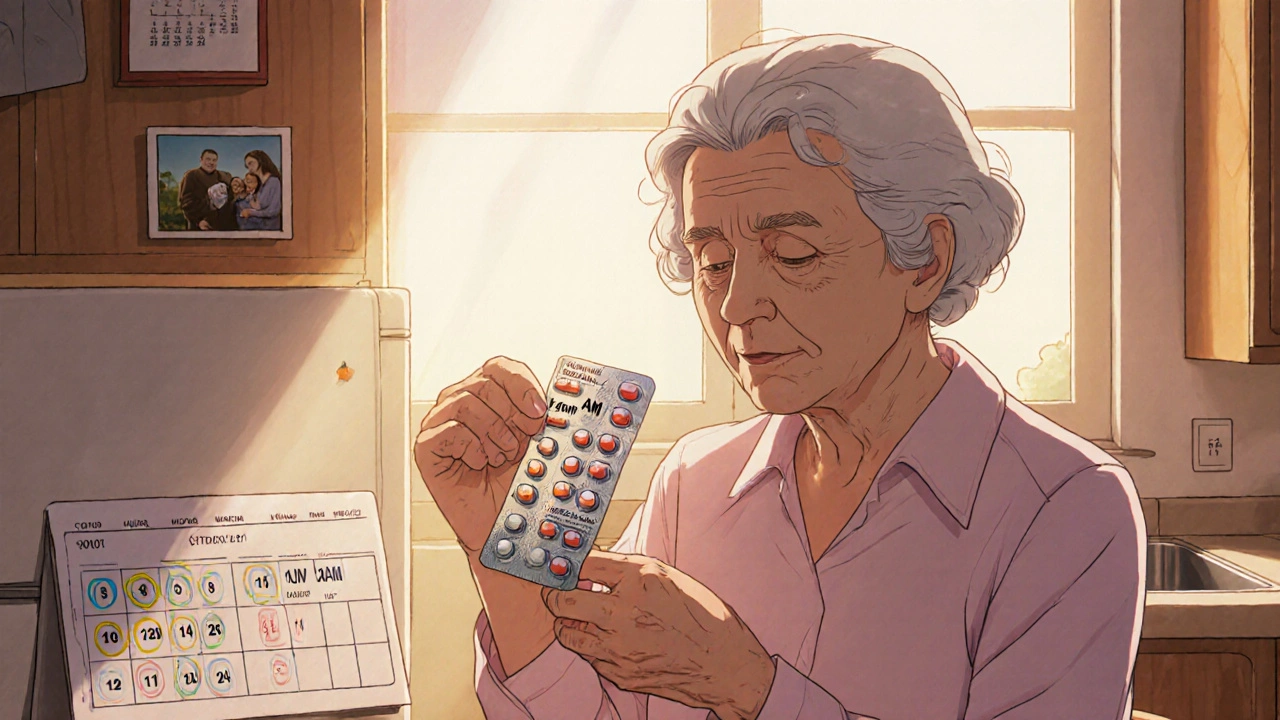Every year, over 250,000 people in the U.S. end up in the hospital because they took the wrong pill, too much of a pill, or missed doses entirely. Many of these mistakes are preventable. For people juggling multiple medications-especially seniors or those with chronic conditions-blister packs and pill organizers aren’t just convenient tools. They’re lifesavers.
Why Medication Mistakes Happen
It’s easy to assume that if you’re taking pills every day, you’ll remember when and how. But reality is messier. A 2022 study found that nearly half of all people with chronic illnesses don’t take their meds as prescribed. Why? Too many bottles. Confusing schedules. Memory lapses. Dexterity issues. Even something as simple as a pill bottle with a faded label can lead to disaster. Imagine this: You’re taking five different medications. One for blood pressure, one for diabetes, a pill for cholesterol, another for pain, and a supplement. You fill your own pillbox every Sunday. You’re tired. Your hands shake a little. You grab the wrong bottle. Suddenly, you’ve taken two doses of your blood pressure med. That’s not hypothetical. That’s a real emergency room visit waiting to happen. That’s where blister packs and pill organizers come in. They cut through the chaos.What Are Blister Packs?
Blister packs-also called multi-dose packaging or pre-sorted med packs-are sealed plastic cards with individual compartments for each dose. Each bubble holds one pill, clearly labeled with the day and time: Monday AM, Tuesday PM, Thursday Bedtime. They’re made by specialty pharmacies and delivered to your door, fully filled and ready to use. Unlike regular pill bottles, blister packs remove the guesswork. You don’t count pills. You don’t sort them. You just open the next bubble when it’s time. No room for error. A 2022 study in the American Journal of Epidemiology tracked 180 older adults with hypertension. Those using blister packs had an 87.4% adherence rate. Those using standard bottles? Only 64.3%. That’s a 35% jump in consistency-just from switching packaging. Blister packs also reduce accidental overdoses. If you see an empty bubble where a pill should be, you know you already took it. No second-guessing. No taking the same dose twice. A 2023 report from Home Instead Senior Care found blister packs cut medication errors by 67% compared to traditional vials.What Are Pill Organizers?
Pill organizers are reusable containers with compartments for each day-or multiple times a day. Basic ones have seven slots: one for each day of the week. More advanced ones have four compartments per day: morning, noon, evening, bedtime. Some even have alarms or locking lids. They’re cheap-usually under $15-and easy to find online or at pharmacies. But here’s the catch: you have to fill them yourself. That’s where the risk creeps in. If you’re filling a weekly organizer with 28 pills, one wrong swap can throw off your whole week. A 2021 study of arthritis patients found that 37% of users made mistakes while refilling their organizers. One woman on AgingCare.com shared that her dad with dementia kept taking extra doses because he thought he’d missed them. Switching to blister packs stopped the ER visits. Pill organizers work best for people with simple regimens and good memory. They’re not ideal if your meds change often, or if you have shaky hands or poor eyesight.Blister Packs vs. Pill Organizers: Which Is Better?
| Feature | Blister Packs | Pill Organizers |
|---|---|---|
| Who fills it? | Pharmacy | You or caregiver |
| Accuracy | 98% | 82% (with manual filling) |
| Adherence improvement | 23-28% | 10-18% |
| Cost per month | $45-$105 | $5-$20 (one-time) |
| Best for | 4+ daily meds, memory issues, complex schedules | Simple regimens, stable meds, good dexterity |
| Changes to meds? | Requires repackaging | Easy to adjust |
| Storage needs | Room temp only | Room temp only |

How to Get Blister Packs
You can’t buy blister packs off the shelf. You need a pharmacy that offers multi-dose packaging. Most Medicare Advantage plans cover them. So do many long-term care facilities. Here’s how to get started:- Call your pharmacy and ask if they offer blister pack services. If they say no, ask for a referral to a specialty pharmacy.
- Provide your full medication list-including dosages, times, and any new prescriptions.
- Wait 3-5 business days for your first pack to be prepared.
- When it arrives, sit with a caregiver or pharmacist for 15 minutes to learn how to open the bubbles and check for missing doses.
- Ask for a printed schedule with pictures of each day’s bubbles. Many pharmacies include these.
How to Use Pill Organizers Right
If you’re using a pill organizer, do it right:- Use one with separate compartments for morning, afternoon, evening, and bedtime-not just one per day.
- Choose transparent plastic so you can see what’s inside. No surprises.
- Use a permanent marker to label each compartment with the time (e.g., “7 AM,” “7 PM”).
- Fill it every Sunday, right after you pick up your prescriptions. Don’t wait until Monday morning.
- Keep your original pill bottles in a safe place. Use them to double-check what goes in the organizer.
- Check each compartment daily. If a pill is missing, don’t assume you took it-check your bottles.
What Doesn’t Work
Some people try to save money by using egg cartons, old pill bottles, or ziplock bags. Don’t. These are dangerous. Labels fade. Pills get mixed. You can’t tell what’s what. Also, don’t rely on memory alone. Even if you’ve taken the same meds for years, your brain changes. Stress, sleep loss, or aging can make you forget-even if you’re sharp. And don’t assume your doctor knows your full list. Many patients take over-the-counter pills, supplements, or herbal remedies that interact with prescriptions. Always tell your pharmacist everything you take.


 Medications
Medications